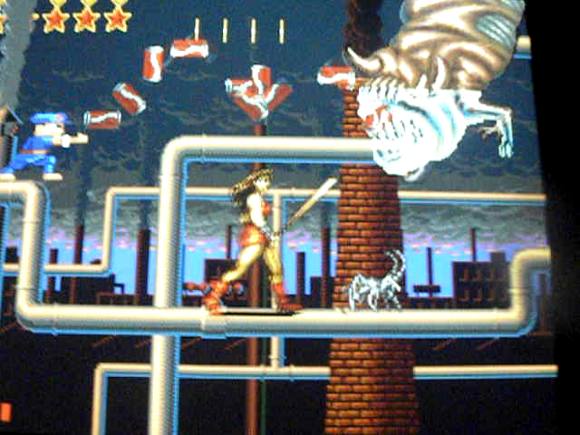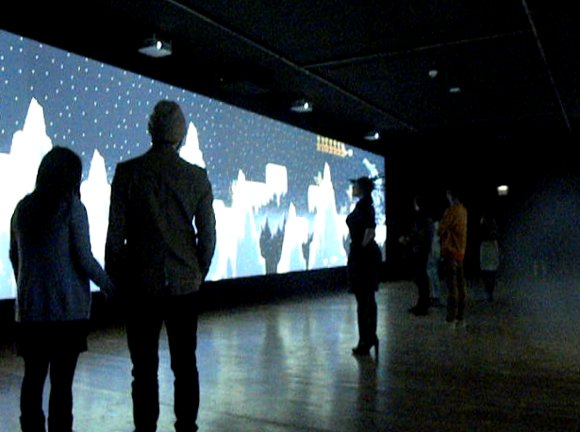
-- A Cyberspace Review Of The Arts
Volume 18.02
February 17, 2011
|
On January 23d, in the face of bitter cold and stubborn snow, PS1 in Queens had a major opening of not one, not two, but at least six large, rather impressive shows. I'm going to focus on two of the shows: a set of works by New York artist Laurel Nakadate, and a huge video game, by Feng Mengbo of Beijing, and try to get to the others another time.
Laurel Nakadate: 'Only The Lonely'Nakadate, who was born in 1975 and survived an MFA from Yale University in 2001, lives and works in New York City and has hitherto been best known for film and video works, some of which are on view here. Nakadate's most imposing work in the present show is a series of photographs, presented as rather large, dark, glossy prints, which show her weeping; there is one for every day in the year (the year being January 1 through December 21 of 2010). The prints are of high quality and given their luscious, smooth darknesses and their large number could not have been anything but laborious to print, inspect, consider, reprint, and so forth, high technology or not. They were massed on the walls one can only say thickly; I didn't count them, but I assume the whole set of 365 were present. My feelings about this part of the show were strongly ambivalent. On the one hand, there is always reason to weep — there are tears in everything, as Virgil says. On the other hand, doesn't so much weeping, so repetitiously illustrated, trivialize it? Or perhaps render it meaningless, like a word repeated over and over? But maybe that's the message — 'Tears cried for no one, a love that should have lasted years.' I also viewed another of Nakadate's pieces, a video wherein she went to a 'love hotel' in Japan (I probably don't need to explain the term) and rented a room for a few hours, but instead of going there with a partner she went with a camera and made a video of herself as if carrying on sexually with an invisible (because non-existent) person. Of course, it would be very difficult to do this in a convincing manner with no other body there, so the movements were, perhaps deliberately, unconvincing, an act that is supposed to be very obviously an act. Some of the movements and gestures seemed to have been derived from pornographic clichés, but for all I know these may now be common practice in real life as well as in the movies. I suppose this was a case in in which Hell, instead of being other people, is oneself. I should add that the videos are in no way actually pornographic, at least not to my sensibilities. The artist also showed videos made in the homes of men she has picked up more or less by chance at previous performances, in which she imitates the act of one famous song'n'dance girl or another, perhaps Britney Spears, 'for' the chance acquaintance, although really for the camera, while the man looks on or perhaps participates, in a manner of speaking; usually he appears to be at a loss, probably embarrassed. I take it none of the scenes were much scripted or rehearsed and I believe the point is precisely the alienation and ungainly social disjunctions they display. These are not the only things on display, but they are representative. The show was well-titled — 'Only The Lonely' -- but I don't know if Chairman Frank would approve of it. Well, maybe he would.
Feng Mengbo: 'Long March: Restart (2008)'The 'video game', by Feng Mengbo, an artist based in Beijing, was 'acquired' by MoMA, whatever that means in the age of digital technology, but perhaps was deemed a bit too fizzy for the staid Modernism of 53d Street and sent to the provinces. In any case, it takes up a lot of space, and real estate is always a problem in the big city. It is a huge, immersive, interactive video game of the old-school 2D scrolling type, such as Super Mario Brothers, but in this one the imagery was largely based or themed on Chinese Communist revolutionary symbols. Since the game screen covers the two long walls of a rather large room, 'immersive' is the right word: the game screens, indeed, often the beings on the screen, are larger than the people in the audience. Playing it, one must move oneself physically to stay with the avatar one is playing. The game has a wireless controller so that players can direct their avatar, always a Chinese revolutionary soldier, to fight various demons, robots, metallic octopuses, tanks, foreign troops, monsters, gigantic insects, burly babes with baseball bats, zombies, industrial presses, flying saucers, scorpions, sumo wrestlers, and so forth — even a video gamer is stuck in one dark corner. Members of the audience, including your reviewer, were invited to use the controller, and many did. However, the visuals and not the game play were point of the work. One should not overlook the fact that a chief weapon in the hands of the protagonist is a can which looks suspiciously like Coca-Cola. In engineering terms, the work uses a number of overlapping video projectors mounted on the ceiling. (These can compensate for the angle at which the projection strikes the walls, so the scenes displayed do not appear skewed.) Presumably the whole is driven by a computer or computers using gaming software, although the split screens may suggest extensive additional work had to be done in that area. And somebody did a huge amount of art work and scripting just to set up the game's scenery, probably Feng Mengbo, since he is said to have a long history with electronic art. Aesthetically, culturally, we find outselves in a curious world halfway between the old imagery of the Chinese Revolution, Chairman Mao and the Little Red Book, and the new world of high technology, giant computers, glistening spires, big money, world leadership, and so forth — a long march indeed, and apparently a very exuberant one, although not at all without conflict. (I am cognizant that there may be ironies within it which the average Westerner like myself may easily miss.) The immersive quality of the game recalls science fiction stories about such things in which, usually, the game gets after the protagonist to his great disadvantage, but I escaped unscathed. The work — it's hard to know what to call it genre-wise — is truly well done, with respect to the artwork at least, and it does suggest that the aesthetic dimension of video games can be treated as art-for-its-own-sake beyond the realms of gamer nostalgia in which most of it currently reposes. I wonder if any of the video games have broken out of the comic book mold when it comes to art? Probably, if I've thought of it. Back in the old days they were of necessity very abstract — remember Pong? Like the web comic 'Diesel Sweeties', indeed like most comics in history, 2D scrolling games are halfway between a high degree of abstraction and 'realistic' depiction, and what were once considered unfortunate artifacts of insufficiently advanced technology, like pixelization, are now a kind of texture one can play with to aesthetic and possibly sentimental advantage.
Related Links PS1 PS1 Laurel Nakadate Laurel Nakadate Laurel Nakadate (Wikipedia) Laurel Nakadate (Wikipedia)
 Feng Mengbo (Wikipedia) Feng Mengbo (Wikipedia) |
|
|
|
|
|
|
|
|
Gordon Fitch |
|



